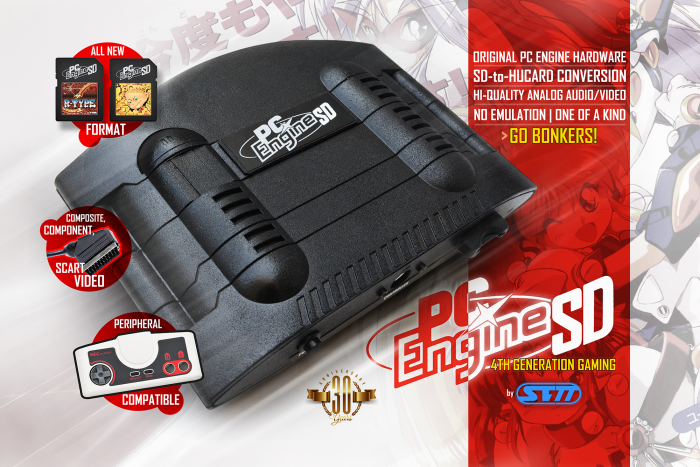Builder of this device posted this over at AtariAge, I thought it was a pretty cool project.
---------------------------------------------------

Building a gaming console to commercial standard production is tough work. It comes with lots of trial and error and a dependence on outside help, expertise and collaboration. With little money, this process is glacial, but with dedication and tenacity, at least some of you will enjoy portable arcade gaming with the STARFORCE PI in the future! Until that time, I continue my quest to reinvent old consoles and bring them into the future. My latest creation: the PC Engine SD
Built inside a converted 1990 Amstrad GX4000 case, the system features an original first-model PC Engine motherboard which means the games aren’t emulated, the best RGB analog audio/video signal through component, composite or SCART output, full compatibility with PC Engine peripherals such as controllers and multitaps, and an SD-to-HuCard reader using the Turbo Everdrive V2.5 supporting all PC Engine and TurboGrafx-16 games. The SD card simply slots in the front, together with the controller (or controllers via a multitap), and the system is ready to be used. No load times – Plug’n’Play!
Relative to my other builds, like the STARFORCE NEO or the upcoming Sega Omega Drive, this was a relatively fast and straightforward build. It took 2 months in total to finish, and cost about €225 to build, including controllers, SCART cable, adapter, and multitap. I would’ve liked to collect for this system, but I noticed prices for PC engine games were just becoming ridiculous, and because I don’t have a childhood connection to the system, I had no problem simply switching to SD cards.
It turned out rather nice! Very simple, still quite compact and attractive, and with a really 1990s edge to the look.
About PC Engine:
It it one of the lesser-known 4th generation video gaming consoles but it was in fact the first released in the era of 16-bit systems. Known as the TurboGrafx-16 in the US, it went after the video gaming juggernaut Nintendo and their 8-bit entertainment system, but ended up competing with the Sega Mega Drive (Genesis) and the SNES in the Console Wars of the early 90s. Sadly, its tiny 8-bit CPU and limited success outside Japan was no match, and faded away by the mid-90s. But it’s a great system and deserves some retrogaming love!
PC Engine SD SPECS:
Authentic NEC PC Engine Model 1 Hardware
PC Engine & TurboGrafx-16 Compatible
1x PC Engine Controller Input (Compatible with 5 Player Multitap)
Composite/Component/SCART RGB Audio/Video Output
SD-to-HuCard Conversion via Turbo EverDrive 2.5
Standard SD Card Compatible (Up to 32GB)
Vintage 1990 Amstrad GX4000 Converted Case
Dimensions: 25 x 4.4 x 18.4 cm, Weight: 0.9kg (2lbs)
https://starforcepi.wordpress.com/2017/04/19/the-pc-engine-sd/